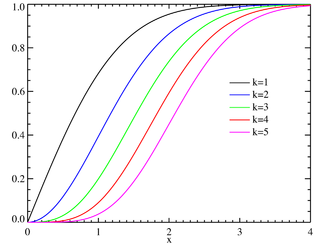- Chi distribution
-
chi Probability density function

Cumulative distribution function

parameters:  (degrees of freedom)
(degrees of freedom)support: 
pdf: 
cdf: 
mean: 
mode:  for
for 
variance: 
skewness: 
ex.kurtosis: 
entropy: 

mgf: Complicated (see text) cf: Complicated (see text) In probability theory and statistics, the chi distribution is a continuous probability distribution. It is the distribution of the square root of the sum of squares of independent random variables having a standard normal distribution. The most familiar example is the Maxwell distribution of (normalized) molecular speeds which is a chi distribution with 3 degrees of freedom (one for each spatial coordinate). If Xi are k independent, normally distributed random variables with means μi and standard deviations σi, then the statistic
is distributed according to the chi distribution. The chi distribution has one parameter: k which specifies the number of degrees of freedom (i.e. the number of Xi).
Contents
Characterization
Probability density function
The probability density function is
where Γ(z) is the Gamma function.
Cumulative distribution function
The cumulative distribution function is given by:
where P(k,x) is the regularized Gamma function.
Generating functions
Moment generating function
The moment generating function is given by:
Characteristic function
The characteristic function is given by:
where again, M(a,b,z) is Kummer's confluent hypergeometric function.
Properties
Moments
The raw moments are then given by:
where Γ(z) is the Gamma function. The first few raw moments are:
where the rightmost expressions are derived using the recurrence relationship for the Gamma function:
From these expressions we may derive the following relationships:
Mean:

Variance:

Skewness:

Kurtosis excess:

Entropy
The entropy is given by:
where ψ0(z) is the polygamma function.
Related distributions
- If X∼χk(x) then
 (chi-squared distribution)
(chi-squared distribution)  (normal distribution)
(normal distribution)- If
 then
then  (half-normal distribution) for any
(half-normal distribution) for any 
 (Rayleigh distribution)
(Rayleigh distribution) (Maxwell distribution)
(Maxwell distribution) (The norm of n standard normally distributed variables is a chi distribution with k degrees of freedom)
(The norm of n standard normally distributed variables is a chi distribution with k degrees of freedom)- chi distribution is a special case of the generalized gamma distribution
Various chi and chi-squared distributions Name Statistic chi-squared distribution 
noncentral chi-squared distribution 
chi distribution 
noncentral chi distribution 
See also
External links
Categories:- Continuous distributions
- Normal distribution
Wikimedia Foundation. 2010.
















